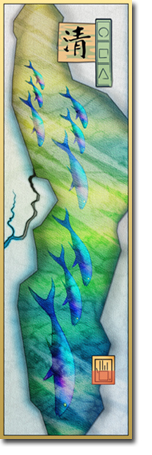On The Way: The Daily Zen Journal
Wake-up Sermon – Part 3
Bodhidharma (440-528)
That which follows is witnessed on the Way. It’s beyond the ken of arhats and mortals.
When the mind reaches nirvana, you don’t see nirvana. Because the mind is nirvana. If you see nirvana somewhere outside the mind, you’re deluding yourself.
Every suffering is a buddha-seed. Because suffering impels mortals to seek wisdom. But you can only say that suffering gives rise to buddhahood. You can’t say that suffering is buddhahood. Your body and mind are the field. Suffering is the seed, wisdom the sprout, and buddhahood the grain.

The buddha in the mind is like the fragrance in a tree. The buddha comes from a mind free of suffering, just as fragrance comes from a tree free of decay. There’s no fragrance without the tree and no buddha without the mind. If there’s a fragrance without a tree, it’s a different fragrance. If there’s a buddha without your mind, it’s a different buddha.
When the three poisons are present in your mind, you live in a land of filth. When the three poisons are absent from your mind, you live in a land of purity. The sutras say, “If you fill a land with impurity and filth, no buddha will ever appear.” Impurity and filth refer to delusion and the other poisons. A buddha refers to a pure and awakened mind.
There’s no language that isn’t the Dharma. To talk all day without saying anything is the Way. To be silent all day and still say something isn’t the Way. Hence, neither does a tathagata’s speech depend on silence, nor does his silence depend on speech. Nor does his speech exist apart from his silence.
Those who understand both speech and silence are in samadhi. If you speak when you know, your speech is free. If you’re silent when you don’t know, your silence is tied. If speech isn’t attached to appearances, it’s free. If silence is attached to appearances, it’s tied. Language is essentially free. It has nothing to do with attachment. And attachment has nothing to do with language.
Reality has no high or low. If you see high and low, it isn’t real. A raft isn’t real. But a passenger raft is. A passenger who rides such a raft can cross that which isn’t real. That’s why it’s real.

According to the world, there’s male and female, rich and poor. According to the Way, there’s no male or female, no rich or poor. When the goddess realized the Way, she didn’t change her sex. When the stable boy awakened to the Truth, he didn’t change his status.
Free of sex and status, they shared the same basic appearance. The goddess searched twelve years for her womanhood without success. To search twelve years for one’s manhood would likewise be fruitless. The twelve years refers to the twelve entrances.
Without the mind there’s no buddha. Without the buddha, there’s no mind. Likewise, without water there’s no ice, and without ice there’s no water. Whoever talks about leaving the mind doesn’t get very far. Don’t become attached to appearances of the mind. The sutras say, “When you see no appearance, you see buddha.” This is what’s meant by being free from appearances of the mind.
Bodhidharma (440-528)
Excerpted from The Zen Teaching of Bodhidharma trans by Red Pine 1987





Some teachings build on a foundation that seems elementary and principles that everyone would agree would make the world a better place…if we all followed the Golden Rule, for instance.
The teachings of Bodhidharma are of the highest and require listening on multiple levels at once.
The first is the most basic level where we just want to understand what the words seem to be communicating, and that works fairly well in a conventional sense.
But quickly the conversation leaves the rational plane and enters a place where conventional just no longer translates meaning.
So how do we proceed in understanding this “Wake Up” sermon? The simplicity of Zuigon’s practice every day was to start out something like this,
Zuigan called to himself every day, “Master!” and answered, “Yes, sir!”
“Wake up, wake up!” and answer, “Yes, sir!”
“And don’t be deceived by others!” “No, I won’t!”
And truly, for many people that would be enough. Then we come to:
The appearance of appearance as no appearance can’t be seen visually but can only be known by means of wisdom
And many of us stop in our tracks.
Now we have to turn to our way of reading and understanding Dharma. Dharma eyes and ears are, obviously, in a different realm from ordinary life. This requires stretching in understanding multiple levels.
Until those Dharma eyes and ears have opened, much of Zen seems incomprehensible.
At this point in a reading stopping and rereading a passage helps us to absorb it beneath the skin line. Even if we are puzzled and know it means something else, we also can realize that it is speaking to us on a deeper level. That trust in the Way is not a flip, “yeah, I’ve heard that before, now I really get it.”
It involves a softening and receptivity, residing in that moment before we understand. And truly, any teacher who can help us realize that, really, we know next to nothing is doing us a great service.
There are many more leaps in this piece, most of which cannot be explained away by anyone. These comments are just intended here as pointers to help you avoid accepting or rejecting too quickly…
Walking straight up the mountain,
Elana, Scribe for Daily Zen